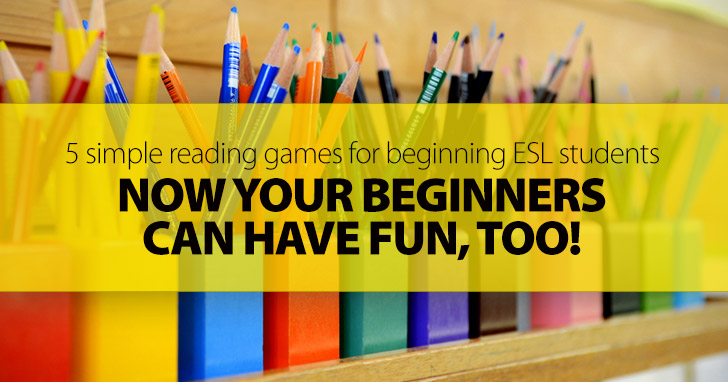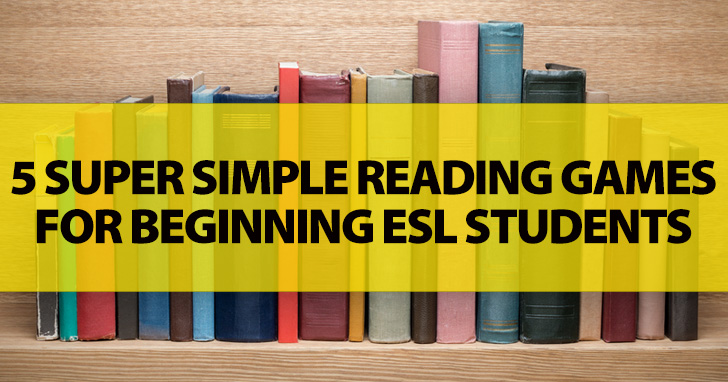Now Your Beginners Can Have Fun, Too: 5 Simple Reading Games For Beginning ESL Students


These games are perfect for the younger or inexperienced English student who wants to have fun while they practice reading.

This fun game gets kids moving and reading at the readingsame time. You will be setting up a tape town on your classroom floor (you can also use a really large table), and your students will be “driving” a car to pick up their friends for a party at the school. Start by having each student in your class make a construction paper house. The house can be elaborate or simple as best fits your class. Then each house gets a name. You can create the names using the vocabulary words you want your students to practice reading, for example the Bat Cave, the Basket Building, or the Goal Home. (You might want to write these names ahead of time on labels so you can easily stick them to each house.) Label each house with a name. Now have students position their houses around the area you are using for your tape town, and make sure you have a school in the town, too. Then use wide painters tape to make roads throughout your town. These roads will also need names made up from your vocabulary unit: Basketball Ct, Soccer St, Bat Ave, and Stadium St, for example. Use your prewritten labels to give each street a name. Now it’s time to play. One student starts at the school with a toy car. That person draws another student’s name from a hat and asks them which house is theirs. The player then drives the car to that person’s house reading each street he drives along to get to their house. He must then return to the school using a different route, again reading each of the street’s names on his way. Once he is at the school, the student he just picked up takes a turn and draws another name from the hat and “drives” to pick that person up from their house. Play continues until everyone is at the school and the party starts.
In this game, students compete to build the highest block tower that does not fall. It works best with small groups (two to four students), but you can modify it for larger groups or the entire class. Start by getting a set of simple blocks and writing one reading word on each block. (Use stickers or labels if you want to change the words each time you play.) You can use children’s building blocks, a set of Jenga blocks, even milk jug caps - whatever you have handy that students can stack. Put the blocks in a bag. Students take turns drawing one block from the bag, reading the word written on it, and then placing that on their stack. They can only use one hand when placing it, and they cannot touch any of the blocks they have already placed on the tower. Students take turns until all the blocks are gone or until only one tower remains. Throw the blocks back in the bag and you are ready to play again!
This game takes some time to prepare, but once you do your students will have a blast playing it over and over. It’s based on the classic children’s game Candyland where kids draw color cards to get to the end of a road. In this version, instead of drawing color cards your students will be drawing reading cards. Start by making two identical sets of cards to use in the game on two different colors of index cards or card stock. Each set should have five copies each of ten reading words for a total of fifty cards in each set. Students set up the game by taking one set of cards, shuffling them, and then arranging them in random order to form a road on the playing surface. The other set of cards is the draw pile. Each player gets a game piece (if you are looking for a fun craft that you can use over and over in class, try making your own personalized game pieces), draws a word from the draw pile, reads it, and looks for the first appearance of that word on the road in front of their game piece. She then moves her piece to that space. Players take turns drawing words and moving to the closest appearance of that word on the road in front of them. (If players run out of draw cards, shuffle the discarded ones and use them again.) The first player to reach the end of the road wins the game.
I love dollar stores and all the great materials they have that can be used in the classroom, and buying them won’t break the bank. This game uses two simple puzzles with around twenty pieces each that you can find at almost any dollar store. (If you have a large class, you might want one puzzle for each group of four or five students if you want everyone to do activity at the same time.) You’ll have to get the puzzles ready before doing this activity in class, but it’s not hard to do so. Assemble each puzzle. You will need access to the BACKS of the puzzle pieces, so either assemble it face down or plan to flip it once you have the puzzle together. Plan a short story, which you will write on the back of the puzzle – one word per piece. Do this for each puzzle using a different color marker to label each puzzle. Put the pieces for each puzzle in a separate bag, and you are ready to play. Either divide your class into teams or have individuals play. On their turn, students pull one piece for their puzzle out of the bag and read the word on the piece. If they read it correctly, they keep the piece and try to fit it into their puzzle. If they read the word incorrectly, they must put the piece back in the bag. Continue taking turns until someone’s puzzle is complete. They must then read the entire story aloud to win the game.
I don’t know why a simple piece of bubble wrap can be so entertaining, but it seems like no one can resist popping those irresistible air pockets encased in plastic. This simple reading game takes advantage of that inherent desire to pop, pop, pop our way to happiness. Start with a small piece of bubble wrap (one where the bubbles are about the size of a quarter), and write a (secret) sentence on it, one word to a bubble. Make sure you leave plenty of bubbles between the ones you write on. Then write a reading or vocabulary word on each of the remaining bubbles. Be careful you don’t repeat any of the words that are in your secret sentence when you fill in the empty bubbles. To play, call out one of the reading or vocabulary words you want your students to read. When they find that word, they pop the bubble. Continue calling out and popping one word at a time until only the words from the secret sentence remain.